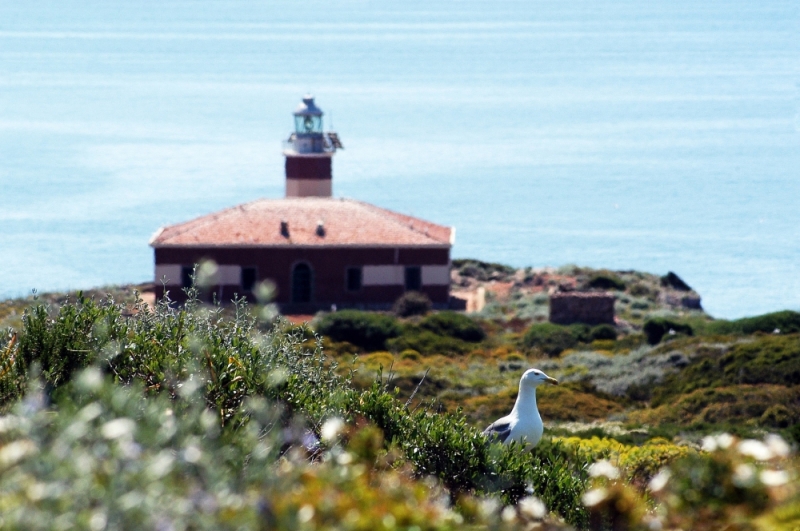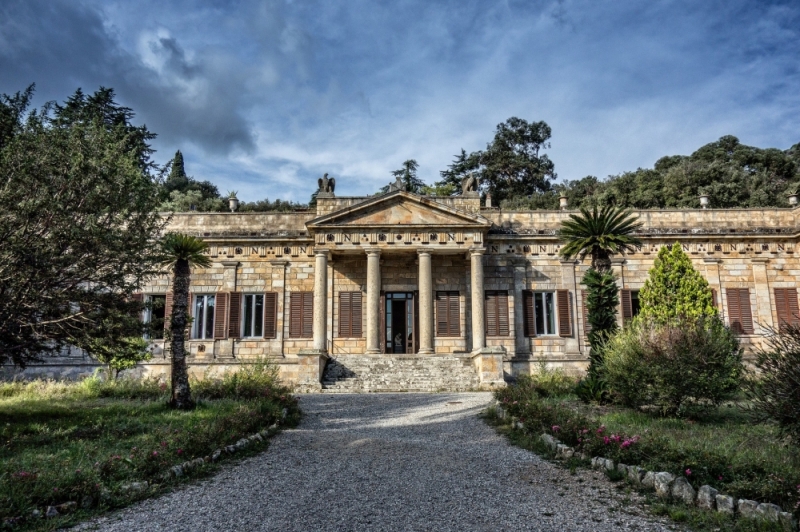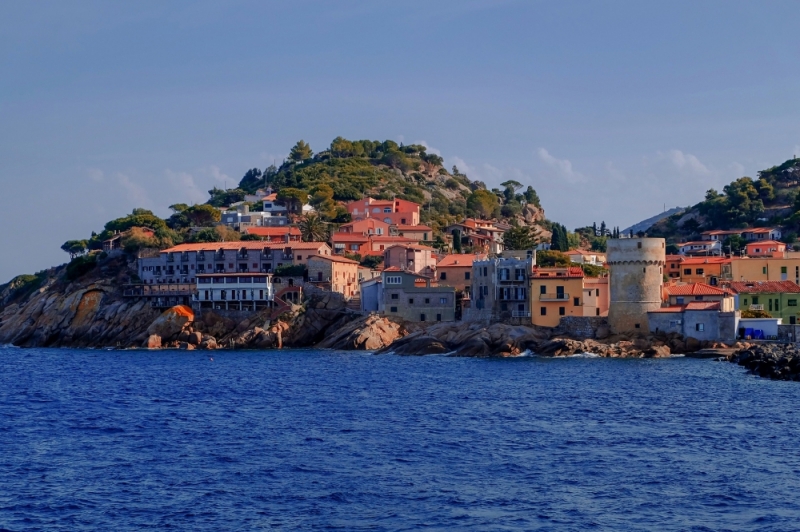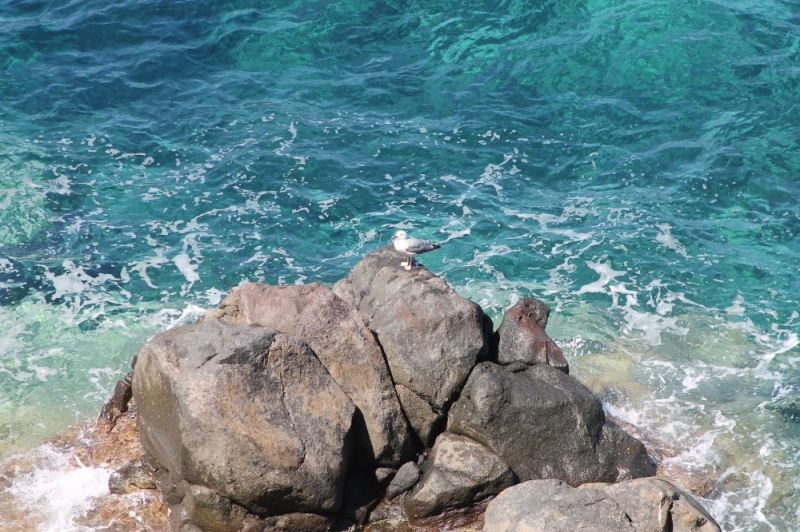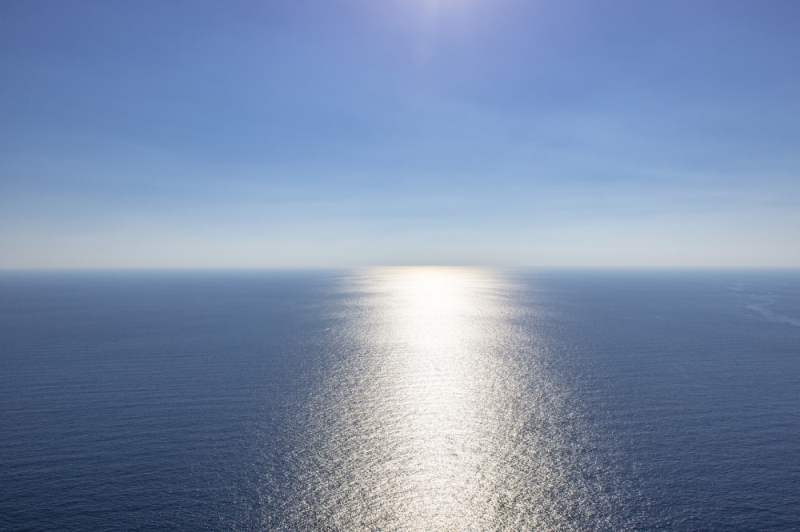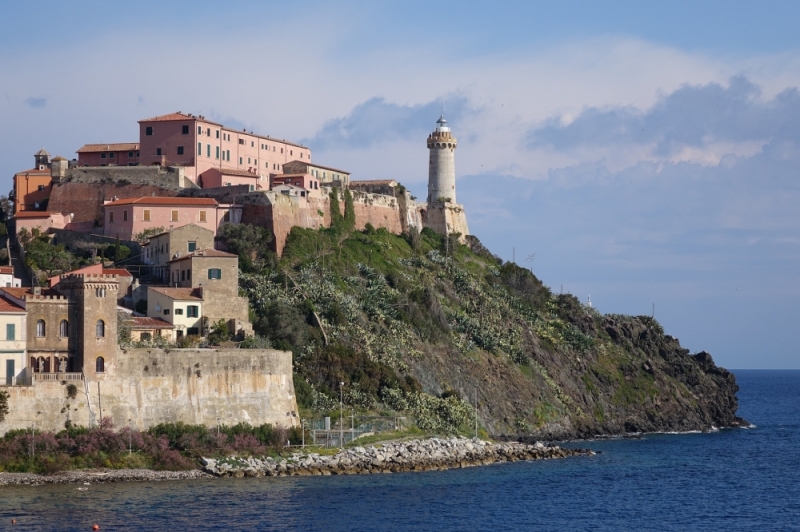The islands of the Tuscan sea
The Tuscan Archipelago is located in that stretch of the Tyrrhenian Sea between Tuscany and Corsica and is made up of 7 main islands plus a series of smaller islands surrounded by islets and emerging rocks. The largest islands are the island of Elba, the island of Giglio, Capraia, the island of Montecristo, Pianosa, Giannutri and Gorgona. All the islands, islets and rocks are part of the Tuscan Archipelago National Park, a national park established in 1996 to protect the uncontaminated flora and exclusive fauna of these places. The Archipelago can be reached by ferries that leave from the port of Piombino or thanks to the airport on the Island of Elba, it is possible to take direct flights from the airports of Pisa, Florence and Milan, but also from Zurich, Bern and Moanco di Bavaria.
Elba island
Elba is the largest of the islands of the Tuscan Archipelago. In its 223 km² of extension, the territory is divided between 7 municipalities belonging to the province of Livorno. Elba was already inhabited by the Paleolithic era but the Etruscans were the first to settle in some villages, attracted by the iron and granite deposits present on the island. Subsequently, the island came under the dominion of the Roman Empire, of which the remains of 3 villas have been discovered. The Romans created the first inhabited center, Porto Argo, which over the centuries has grown to become the current Porto Ferraio , the largest municipality on the island. Other towns on the island are Campo dell'Elba, where there is also the only airport in the archipelago, then there are Capoliveri, Marciana and Marciana Marina, Porto Azzurro and Rio. In addition to the presence, in the past, of the Etruscans and Romans, history buffs on holiday on the island of Elba, can visit the places where Napoleon Bonaparte lived here the days of his exile, following the defeat suffered in Leipzig . Napoleon was appointed prince of the island and dedicated himself to his administration, having buildings and infrastructures built. During the Napoleonic principality, the island of Elba became the cultural and political center of the time. Today it is possible to visit the Museum of Napoleonic Residences , consisting of the Palazzina dei Mulini and Villa San Martino , the two residences that the French emperor chose for himself and for the elderly mother and sister who followed Napoleon in his exile. Elba is a very large island, rich in different landscapes ranging from the sea to the mountains, as there is a mountain on the island, Monte Capanne , which with its 1019 meters is the highest peak on the island. The summit of the mountain can be reached in about 20 minutes with the cable car that starts from the municipality of Marciana or, for trekking lovers, there are numerous itineraries to go through the massif, to get to the top enjoying beautiful views during the climb. Along the way you can admire holm oak and chestnut woods, but also typical plants of the Mediterranean scrub. Also, if you're lucky, you may come across deer, mouflons and even the peregrine falcon. Once you reach the top, you can enjoy a beautiful panorama from which you can see the whole island, as well as the other islands of the archipelago immersed in the deep blue of the Tyrrhenian Sea. For those who love the sea and scuba diving, we recommend moving south, in the Pomonte area , a diving area. Yes, because here, near the Ogliera rock , there is the wreck of a merchant ship sunk in 1972. For all those who choose to go on holiday to the island of Elba, especially for the sea and the beaches, we recommend to visit the most famous and most beautiful beaches of the Tuscan island: Spiaggia delle Ghiaie is the beach of the town of Portoferraio and is located not far from the historic center of the city. The beach is famous for its wonderful backdrops of white pebbles that make the water an intense blue, similar to a swimming pool. Here all snorkelers and even children with a simple mask will be able to see wonderful fish. Another beach not to be missed is that of Fetovaia , which is instead located in the municipality of Campo dell'Elba. The beach is protected by a promontory which shelters it from winds from the north. This is one of the most suggestive beaches of the island as its turquoise waters and white sand give a Caribbean appearance.
Lily island
Giglio Island is the second largest island of the Tuscan Archipelago. The island is located in front of Grosseto, the province to which it belongs. The small island of Giannutri is also part of the island's territory, located south-east of the island. The island was inhabited as early as the Iron Age and later became an Etruscan military base, to then pass under the dominion of the Roman Empire, even though Julius Caesar names the island already in one of his writings. . The island was often sacked by Turkish pirates, between 1540 and 1799. The looting by the pirate Barbarossa is famous, who in 1544 destroyed the island and enslaved the inhabitants of the island. You will arrive at Giglio thanks to the ferries that leave from the opposite Porto Santo Stefano and dock at the pier of Giglio Porto , the port as well as the main center of the island. The first thing to do is to see the beaches, which are many and all very different. Furthermore, the turquoise color of the waters will not make you regret having preferred Giglio Island to a Caribbean island. Just near Giglio Porto there is the beautiful Baia delle Cannelle , very popular with day tourists. It is a beach with very fine white sand and a turquoise sea that you won't forget so easily. For the most romantic, the best beach is that of Campese which with its famous faraglione and the characteristic red sand is one of the most visited beaches on the island. In order to fully enjoy the wonders of this island, we recommend renting a boat or taking part in one of the organized tours that allow you to see the whole island by sea. There are sensational glimpses, colored backdrops and lots of fish. Snorkelers will be amazed. The island is divided into many villages and one of the most beautiful is certainly Giglio Castello , the highest village on the island, with buildings dating back to the fifteenth century, such as the Church of San Pietro , the main church of the island where they are preserved the treasure of Pope Innocent XIII and the relics of San Mamiliano, patron of the island. Another attraction of the island of Giglio are the lighthouses. There is, in fact, a special tour, which allows you to take a tour of the island to admire the lighthouses on the island. There are in fact, the Capel Rosso Lighthouse , which is located on a white and red building, built in 1883 by the Navy. Then there is the Faro del Fernaio , positioned parallel to that of Capel Rosso, however in the northern part of the island, also built in 1883. These two lighthouses were in fact built to replace the historic Faro delle Vaccarecce which is located in a a cliff in the north of the island. Among the various tours to do, we also recommend visiting Giannutri , the nearby island belonging to the Giglio area, inhabited by a few dozen inhabitants. Giannutri is a true paradise because, belonging to the Tuscan Archipelago National Park, its flora and fauna include many protected species, such as specimens of beautiful birds that go to the island to nest, sea turtles that occasionally is you can see swimming around the island, but also sponges, sea fans and corals; therefore Giannutri still manages to maintain his wild aspect. This is a paradise for divers and snorkelers. In addition, on the seabed you can also see the wrecks of some ships that wrecked a few kilometers from the coast.
Capraia island
Capraia , fourth island of the Tuscan Archipelago, is located halfway between Tuscany and Corsica, in that stretch of sea that is part of the Cetacean Sanctuary , a protected marine area where there is a massive concentration of cetaceans that come here attracted by the large amount of food. Capraia owes its name to the fact that here, since ancient times, there were specimens of wild goats, unfortunately now extinct. Capraia, in fact, seems to have been inhabited since the protohistoric period, of which remains of pottery and also tools for weaving have been found. Other testimonies instead concern the presence of the ancient Romans who established their anti-pirate fleet on the island. But Capraia is famous above all for having hosted the prison of the Agricultural Colony of Capraia , until 1986. On the island there are only two inhabited centers, Capraia Porto and Capraia village. In Capraia Porto you will get there with the ferries that leave the port of Livorno every day and you will be greeted by a row of colorful houses overlooking bars and restaurants. This is the only landing place on the island and many vacationers choose to stay at the port to have the sea nearby and choose to rent a boat or take one of the organized tours that allow you to go around the island. By bus, or by renting a scooter, but also with a nice walk, you can get to Capraia village which is located about 1 km from the port. The town of Capraia is located at the foot of a hill on which, around 1540, a fort was built, the Fort of San Giorgio which was built to protect the inhabitants of the island from pirate raids. The town is really very characteristic, consisting of small streets, stairways and "caruggi", typical paths built when Capraia was part of the Republic of Genoa, in the 14th century. There are numerous testimonies of the presence of the Genoese, such as the Forte di San Giorgio itself which was rebuilt by the Genoese, after the pirates had destroyed the previous fortress built by the Pisans. The Torre del Porto was also built by the Genoese; this tower, now restored, was used to defend the island from Corsair attacks. Another Genoese tower is Torre dello Zenobito , which is part of the group of the 4 coastal towers of the island. This tower is located in Cala Rossa , which would be the ancient crater of the island, as Capraia is of volcanic origin and this is mainly noted by the presence of lava rocks which, in this point of the island, form a wonderful contrast with the sea blue. In these parts, especially snorkeling enthusiasts can dive to get to the Grotta della Foca Monaca , so called because here, in the past, monk seals were sheltered there. For those who prefer the beach, Capraia offers many coves that can be reached mainly by boat, with the taxi service by sea. The only sandy beach on the island is Cala della Mortola , even if, depending on the winds that blow, the beach may or may not be there: Grecale takes it away, Libeccio brings it back. Cala del Ceppo is instead reachable on foot, following a path that starts from the town. From this point of the island you can see the flight of wonderful birds of prey or, diving into the clear blue waters, you can snorkel and admire the seabed full of fish.
Montecristo island
Montecristo Island is famous for being the island where Alexandre Dumas' novel, The Count of Montecristo, is set. This island is part of the natural reserves of the Carabinieri. As such, the island is not freely accessible and the possibilities for visiting it are quite few. In fact, to be able to access it, you must make a request to the Forestry Corps of Follonica, which can approve the request, allowing you to access from Cala Maestra , the only access point on the island. Furthermore, due to its great protected biodiversity, it is not possible to fish or swim and you cannot even stay overnight on the island. The island is among the wildest of the archipelago and, once the Forestry Corps has obtained approval for which, however, there are waiting times of about three years as only 2000 visitors are allowed per year, you can visit the island through three hiking trails that we advise you to do only if you are expert. On the island there is also a botanical garden , a small Museum of Natural History and the Royal Villa where in 1896 Vittorio Emanuele stayed there with his wife during their honeymoon.
Pianosa Island
Just like Montecristo, the island of Pianosa is also subject to strict regulations for visits, since, having been the seat of the prison of the same name until 2011, it could only be visited if in groups organized with special guides. Today, this regulation continues to be in force, despite the fact that the prison has been abandoned, in order to preserve and protect the island's wonderful naturalistic heritage. The connections to Pianosa leave both from Piombino and from the Island of Elba, but you will have to organize your visit well as they are not there every day. Until a few years ago, apart from prison residents, the island was completely uninhabited. Subsequently, thanks also to the closure of the prison, the island began to populate. However, it is not yet possible to stay overnight on the island because, despite being open to tourism, we always try to protect the environment. So, you can choose to stay overnight in Piombino or Elba and then leave for Pianosa. When you arrive on this island we suggest a swim in Cala Giovanna which is also the only bathing spot on the island. Then there are Cala di Biagio and Cala del Bruciato which are wonderful but it is absolutely forbidden to approach. Here also, thanks to the wonderful seabed, among the most beautiful in the whole Mediterranean, you could be lucky and see specimens of Caretta Caretta turtles.
Giannutri island
Giannutri Island is also a protected area that is part of the Tuscan Archipelago National Park, in fact, in order to go hiking, diving or even just swimming in its blue sea, you must follow the Park rules and also get in touch with the official environmental guides on the island. Giannutri has a community importance and is a special protection area, for the presence, in its territory, of particular fauna species and numerous elements of biogeographical interest. The island is inhabited by just over 20 inhabitants, but in the summer, through the ferries that leave from Porto Santo Stefano, not a few tourists arrive. Once you arrive on the island of Giannutri, there are few places where you can go without an environmental guide. One of these is the path that goes from Cala Maestra to Cala Spalmatoio and will allow you to cross the whole island. This path develops through the Mediterranean scrub vegetation present on the island and you will be able to see many specimens of Herring Gull that nest on this island. Through this path, you will also arrive at the remains of the Roman Villa which seems to have belonged to the parents of Emperor Nero. On the island there is also the Punta Capel Rosso Lighthouse , located in the south of the island. Finally, one of the major attractions of the island are its blue sea and its seabed rich in corals, sponges and sea fans.
Gorgona island
Gorgona is the smallest island of the Tuscan Archipelago and being the seat of a penitentiary it is impossible to visit it unless authorized by the Penitentiary Administration, which allows a maximum of 75 visits per day. Furthermore, if the request is accepted, the visit of the island will be possible only if accompanied by an authorized guide. Furthermore, cameras and telephones with which to take photos are prohibited. On the island there are two ancient coastal towers, the Old Tower built by Pisani in the thirteenth century and the New Tower fortified by the De 'Medici family in the second half of the seventeenth century. Very beautiful is also the Church of San Gorgonio, from 1700 which replaces the ancient church which was destroyed in 1500. Not far from the church there are the remains of a monastery dating back to the fifth century. On the island it is possible to visit the Grotta del Bove Marino , where the monk seals often took refuge.
Movida and entertainment
The only island that will allow you to experience nightlife is Elba which, with its many bars in the historic center of Porto Ferraio, is the right destination for aperitifs. If instead you prefer the aperitif on the beach, before returning home after a day at the beach, on all the beaches of the island, the bathing establishments at sunset turn into romantic little bars where, in addition to the aperitif, you can also admire the sunset. Cavoli beach, in summer, becomes the location for many beach parties. There are also discos where you can dance until dawn. But for those who prefer quieter entertainment, there is no shortage of open-air cinemas, where on summer evenings it is possible to see films from the past or the current season. For the children there are also many playgrounds with inflatables and trampolines but also swings and electric mini-cars. In addition, for all shopping lovers there are numerous shops and shops that follow one another in the paths of Porto Ferraio and Marina di Campo, where beautiful markets are also held weekly. In the summer months, on the other hand, it is also possible to find evening markets which flock to the main promenades of the island every summer evenings, and while strolling and enjoying a good ice cream you can also admire local handicrafts. Don't forget to dine in one of the excellent restaurants on the island. You will have the opportunity to dine in exclusive places and to eat excellent fresh and freshly caught fish. Also on the island of Giglio you can find small bars where you can have a tasty aperitif by the sea and enjoy live music. At Giglio there are no discos, as the vancaza that you choose to do on this island is more dedicated to relaxation and nature. There are, however, some excellent restaurants where you can always eat fresh fish for little.
Climate, curiosity and advice
Climate: The climate of the Tuscan Archipelago is Mediterranean and enjoys the mitigating influence of the sea. Summers are hot and dry, while winters are mild and during the winter months there are strong winds of libeccio and grecale. Spring and autumn are the rainiest months. The months of late spring and summer are the best months to be able to enjoy the blue sea of the archipelago and visit all the islands thanks to the continuous communications that are daily between one island and another, which instead becomes rarer in autumn and winter.
Curiosity: The Isola del Giglio jumped to the headlines a few years ago, exactly in 2012, when the cruise ship Costa Concordia passed in the waters in front of the island and hit a group of rocks causing the shipwreck and the death of 32 people on board.
Tips: When you decide to visit the islands of the Tuscan Archipelago, we recommend that you book your visits to the uninhabited islands well in advance. In addition, in addition to the costume and sunscreen, always pack a pair of hiking boots, because on all the islands there are truly wonderful paths to visit. Finally, don't forget the snorkeling mask.


